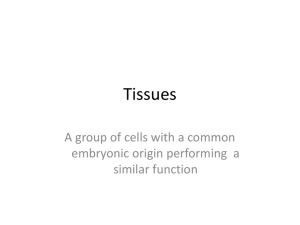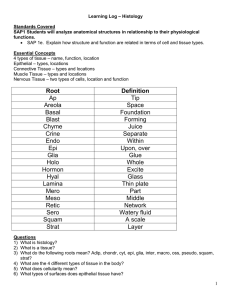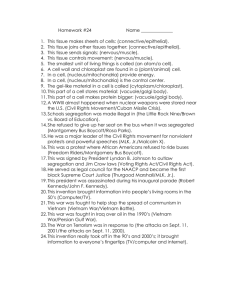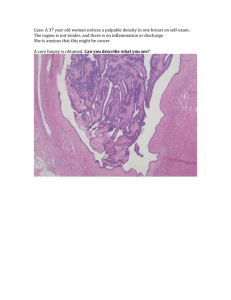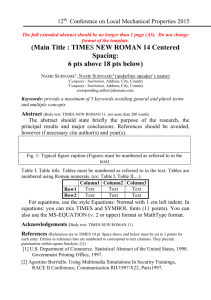Grade 10 Life Science September 2011
advertisement
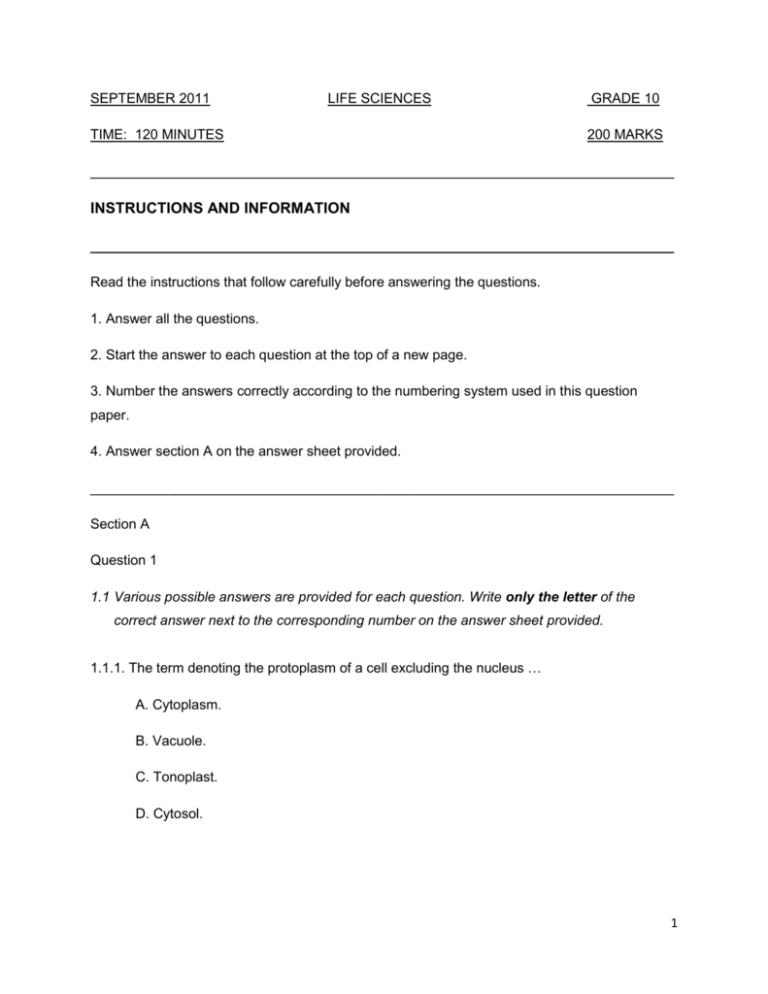
SEPTEMBER 2011 LIFE SCIENCES TIME: 120 MINUTES GRADE 10 200 MARKS ____________________________________________________________________________ INSTRUCTIONS AND INFORMATION ____________________________________________________________________________ Read the instructions that follow carefully before answering the questions. 1. Answer all the questions. 2. Start the answer to each question at the top of a new page. 3. Number the answers correctly according to the numbering system used in this question paper. 4. Answer section A on the answer sheet provided. ____________________________________________________________________________ Section A Question 1 1.1 Various possible answers are provided for each question. Write only the letter of the correct answer next to the corresponding number on the answer sheet provided. 1.1.1. The term denoting the protoplasm of a cell excluding the nucleus … A. Cytoplasm. B. Vacuole. C. Tonoplast. D. Cytosol. 1 1.1.2. A cell is studied under a microscope, which of the following features will indicate that it is an animal cell … A. A large nucleus is observed. B. The cytoplasm has many chloroplasts. C. A large vacuole is observed. D. The cell is surrounded by a thin cell membrane only. 1.1.3. In the following examples the only one not inorganic, is … A. Magnesium. B. Glucose. C. Water. D. Sodium chloride. 1.1.4. Chlorosis is a … A. Deficiency disease. B. Micro-nutrient. C. Component of a chlorophyll molecule. D. Disease caused by a lack of vitamins. 2 1.1.5. Which of the following is used to test for starch? A. Fehling`s solution. B. Benedict`s solution. C. Ether. D. Iodine solution 1.1.6. An iodine deficiency in human diet usually results in … A. Anemia. B. An under secretion of thyroxin. C. Beri-beri. D. Rickets. 1.1.7. A pH level of 2 would most likely be found in … A. Pancreatic juice. B. Gastric juice. C. Saliva. D. Bile. 1.1.8. The form in which excess glucose is stored in the liver is … A. Amino acids. B. Urea. C. Glycogen. D. Glucagon. 3 1.1.9. Hydrolysis of sucrose results in … A. Glucose and fructose. B. Lactose and glucose. C. Maltose and fructose. D. Glucose and galactose. 1.1.10. The tissue that covers external body surfaces, lines internal cavities and forms the secretion portions of glands, is …. A. Muscular tissue. B. Connective tissue. C. Nervous tissue. D. Epithelial tissue. 1.1.11. The tissue that mechanically or physiologically supports other tissues, is …. A. Muscular tissue. B. Connective tissue. C. Nervous tissue. D. Epithelial tissue. 4 1.1.12. The tissue that detects and co-ordinates information about environmental changes and controls responses to those changes is …. A. Muscular tissue. B. Connective tissue. C. Nervous tissue. D. Epithelial tissue. 1.1.13. Which of the following can be classified as a tissue in mammals .… A. Liver. B. Blood. C. Heart. D. Stomach. 1.1.14. The protein in the ground substance of cartilage is …. A. Globulin. B. Chondrin. C. Albumin. D. Fibrinogen. 1.1.15. The type of cartilage covering the articular surfaces in the thoracic vertebra, is A. Areolar tissue. B. Fibrocartilage. C. Hyaline cartilage. D. Elastic cartilage. 5 1.1.16. The liquid part of blood tissue is …. A. Erythrocytes. B. Leucocytes. C. Blood platelets. D. Plasma. 1.1.17. The basic unit of any nervous system is the … A. Brain. B. Muscle cell. C. Synapse. D. Neuron. 1.1.18. Which of the following is NOT a function of mitosis? A. Growth. B. Repair. C. Asexual reproduction in unicellular organisms. D. The formation of sex cells. 1.1.19. In a cell nucleus, the thread-like structures are called ... A. Centrioles. B. Centrosomes. C. Centromeres. D. Chromosomes. 6 1.1.20. The part of the plant cell responsible for providing support is … A. The cell wall only. B. The vacuole only. C. The cell wall and nucleus. D. The cell wall and vacuole. [20X2=40] 1.2 Give the correct term for each of the following. Write only the term next to the relevant question number on the provided answer sheet provided. 1.2.1. The by-product which is formed during A condensation reaction. 1.2.2. A disaccharide of two molecules of glucose. 1.2.3. A deficiency disease characterized by a shortage in vitamin A. 1.2.4. The most important inorganic solvent in nature. 1.2.5. A chemical used in the test for fats. 1.2.6. The epithelium lining the alimentary canal in mammals. 1.2.7. A specialized type of diffusion involving water. 1.2.8. A tough, fibrous connection between a muscle and a bone. 1.2.9. The branched outgrowths of a neuron conducting impulses to the cell body. 1.2.10. The type of cartilage joining ribs to the sternum. 1.2.11. A large sac-like structure found in a plant cell that is surrounded by tonoplast. 1.2.12. A collection of similar cells that perform a specific function. 1.2.13. The mammalian tissue that has become specialised as a storage tissue. 1.2.14. The enzyme responsible for starch digestion in the mouth. 1.2.15. The chemical bonds that link amino acids together. [15x2=30] 7 1.3 Write down the letter of the description in column B which best suits the term in column A. Column A Column B 1.3.1. Emulsifies fat A. Carries away absorbed fat 1.3.2. Fibroblasts B. Muscle cramps 1.3.3 Monomer of protein C. Bile 1.3.4. Lacteal D. Spindle or star shaped cells 1.3.5. Fat E. Required in small amounts 1.3.6. Shortage of sodium F. Acts as an insulator 1.3.7. Process in which enzymes are involved G. Amino acid 1.3.8. Essential in hydrolytic reactions H. Required in large amounts 1.3.9. Macronutrients I. Water 1.3.10. Micronutrients J. Anabolic [10x1=10] [80] 8 Section B Question 2 2.1 Study the diagrams below and answer the questions that follow. A B C 2.1.1 Identify the tissues labelled A, B and C. (3) 2.1.2 Give ONE function of tissue A. (1) 2.1.3 How does the matrix of tissue A differ from the matrix of tissue B? (2) 2.1.4 a) Where in the respiratory system would you find tissue B? (1) b) Give the function of tissue B in the respiratory system. (1) a) In which part of the breathing system would you find tissue C? (1) b) Give the function of tissue C in breathing. (1) 2.1.5 [10] 9 2.2. Study the following epithelial tissues of the human body and answer the questions that follow: 2.2.1. Identify the epithelial tissues marked A, B, C and D. (4) 2.2.2. Name one place in the human body where each of the named epithelial tissue is found. (4) 2.2.3. Name two structural features which the epithelia drawn above, have in common. (2) 2.2.4. In which respects does epithelium B differ from epithelium D in structure? (2) [12] 2.3. The following diagram represents a certain type of human tissue. Study the diagram and answer the questions that follow. 2.3.1. What is the name of this tissue? (2) 2.3.2. State two places in the human body where this tissue is found and its specific function there. (4) 2.3.3. Provide suitable labels for numbers 1, 2 and 3 (6) 2.3.4 What property does structure 1 impart to this tissue? (2) [14] 10 3. Study the diagram of a cell and answer the questions that follow. 3.1.1 Is this a plant or animal cell? Give THREE visible reasons for your answer. (4) 3.1.2 Provide labels for A to F. (6) 3.1.3 Give only the letter for the part of the cell … 3.1.3.1) in which cellular respiration occurs. (1) 3.1.3.2) that forms the spindle fibres during cell division. (1) 3.1.3.3) that controls all cellular metabolism. (1) 3.1.3.4) that controls the entry and exit of substances. (1) 3.1.3.5) that is involved in protein synthesis. (1) [15] 11 3.2 Study the diagram of the human digestive system and answer the questions that follow. . 3.2.1 Provide the labels numbered 1 to 12. (12) 3.2.2 Name the muscle contractions that occur in the part numbered 1. (1) 3.2.3 What is the purpose of the type of muscle contraction mentioned in 3.2.2 (1) 3.2.4 Which digestive juice is secreted by the part numbered 6? (1) 3.2.5 What is the function of hydrochloric acid in the stomach? (1) 2.2.6 Name the condition that arises when the mucus lining of the stomach is destroyed under stressful circumstances? (2) [18] [33] 12 4.1. Look at the diagrams below and answer the questions that follow. 4.1.1. Identify the parts numbered 1 to 5. (5) 4.1.2. Define the term ENZYME. (2) 4.1.3. ls the reaction illustrated in the diagram anabolic or catabolic? Give a reason for your answer. (2) 4.1.4 What is the function of the part numbered 2? (2) 4.1.5 Which numbered part is specifically affected by a change in pH? (2) 4.1.6 Provide an explanation for your answer in question 4.1.5. (2) [15] 13 4.2. Answer the following questions with regard to a type of cell division. 4.2.1 What type of cell division results in daughter cells with chromosome numbers identical to the mother cell? (1) 4.2.2. Give THREE reasons why the type of cell division mentioned in 4.2.1 is biologically important (3) 4.2.3. Study the representations below and identify the FOUR phases of the division process mentioned in 4.2.1 by writing down the LETTER and the NAME of the phase in the correct order. (4) 4.2.4. Does the above representation represent a human somatic cell? Give a reason for answer. (3) [11] [26] 14 5.1. Draw a motor neuron [10] [10] 15 5. From the table identify … Nutrient Per 100 g powder Vitamin A (Retinol) 2 ug Vitamin C (Ascorbic acid) 98 ug Vitamin B (Thiamine) 1.3 ug Vitamin D 0.4 ug Iodine 20 ug Iron 1.3 ug Calcium 540 mg Phospherous 570 mg Protein 14 mg 5.2.1. THREE nutrients that will promote formation of strong bones and teeth. (3) 5.2.2. TWO micronutrients contained in the drink. (2) 5.3 Which nutrient … 5.3.1. Prevents goiter? (2) 5.3.2. Prevents anemia? (2) 5.3.3. Prevents beri-beri? (2) 5.4. Show how you would convert the values in the table of calcium and protein into grams (4) [15] TOTAL 200 16



